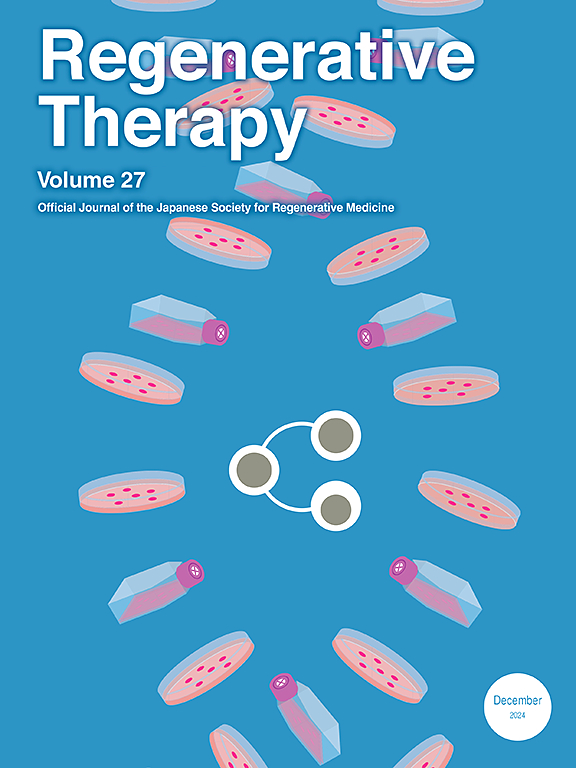神经引导导管内填充结构在大鼠坐骨神经损伤模型中的有效性
IF 3.5
3区 环境科学与生态学
Q3 CELL & TISSUE ENGINEERING
引用次数: 0
摘要
自体神经移植是治疗周围神经间隙损伤的金标准。尽管各种神经引导导管(NGCs)已经被开发出来作为自体移植的替代品,但很少有报道评估NGCs内部结构对神经再生的影响。我们研究了NGCs内部结构对神经再生的影响。方法选取30只雄性Wistar大鼠,切除左侧坐骨神经5 mm段,形成间隙。然后这些动物被随机分成两组。采用7mm聚乙醇酸(PGA)导管,带(PGA-c组)或不带胶原填充(PGA组)来桥接间隙(每组n = 15)。术后2周和4周,对坐骨纵神经切片进行内皮细胞RECA-1、雪旺细胞S100和轴突TUJ1荧光免疫染色。定量评价荧光阳性区域。接下来,32只雄性Wistar大鼠切除左侧坐骨神经10毫米段。随机分为4组:假手术组、自体移植组、PGA-c组(移植12mm PGA-c)、空心PGA组(移植12mm空心PGA),每组8只。术后12周进行形态学评价和神经功能分析。结果在坐骨纵神经切片上,PGA-c组术后2周近端和远端reca -1阳性区域显著大于PGA组,术后2周近端s100阳性区域显著大于PGA组,术后4周近端tuj1阳性区域显著大于PGA组。在10 mm神经缺损模型中,PGA-c组有髓鞘轴突百分比、等长张力、胫骨前肌湿重均显著高于PGA组。结论NGCs内填充结构可为参与神经再生的细胞提供支架,促进神经再生,并可恢复运动功能。这些发现为进一步发展适合周围神经再生的NGCs结构提供了新的见解。本文章由计算机程序翻译,如有差异,请以英文原文为准。
Effectiveness of filling structures within nerve guidance conduits in a rat sciatic nerve injury model
Introduction
The gold standard treatment for peripheral nerve gap injury is nerve autograft transplantation. Although various nerve guidance conduits (NGCs) have been developed as alternatives to autografting, few reports have evaluated the effects of the internal structure of NGCs on nerve regeneration. We investigated how the internal structure of NGCs affects nerve regeneration.
Methods
In 30 male Wistar rats, a 5 mm segment of the left sciatic nerve was resected, creating a gap. The animals were then randomly divided into two groups. A 7 mm polyglycolic acid (PGA) conduit, with (PGA-c group) or without a collagen filling (PGA group), was used to bridge the gap (n = 15 for each group). At 2 and 4 weeks postoperatively, longitudinal sciatic nerve slices were fluorescently immunostained with RECA-1 for endothelial cells, S100 for Schwann cells, and TUJ1 for axons. The fluorescence-positive areas were quantitatively evaluated. Next, 32 male Wistar rats underwent resection of a 10 mm segment of the left sciatic nerve. The animals were then assigned into four groups: sham group, autograft group, PGA-c group (transplantation of 12-mm PGA-c), and hollow PGA group (transplantation of 12 mm hollow PGA) (n = 8 for each group). At 12 weeks postoperatively, morphological evaluations and neurofunctional analyses were performed.
Results
In longitudinal sciatic nerve slices, the PGA-c group had significantly larger RECA-1-positive areas proximally and distally at 2 weeks, larger S100-positive areas proximally at 2 weeks, and larger TUJ1-positive areas proximally at 4 weeks postoperatively than the PGA group. In the 10 mm nerve defect model, the PGA-c group had a significantly higher percentage of myelinated axons, isometric tetanic force, and tibialis anterior muscle wet weight than the PGA group.
Conclusions
The internal filling structure of the NGCs may promote nerve regeneration by providing a scaffold for cells involved in nerve regeneration and may restore motor function. These findings provide new insights into the further structural development of NGCs suitable for peripheral nerve regeneration.
求助全文
通过发布文献求助,成功后即可免费获取论文全文。
去求助
来源期刊

Regenerative Therapy
Engineering-Biomedical Engineering
CiteScore
6.00
自引率
2.30%
发文量
106
审稿时长
49 days
期刊介绍:
Regenerative Therapy is the official peer-reviewed online journal of the Japanese Society for Regenerative Medicine.
Regenerative Therapy is a multidisciplinary journal that publishes original articles and reviews of basic research, clinical translation, industrial development, and regulatory issues focusing on stem cell biology, tissue engineering, and regenerative medicine.
 求助内容:
求助内容: 应助结果提醒方式:
应助结果提醒方式:


